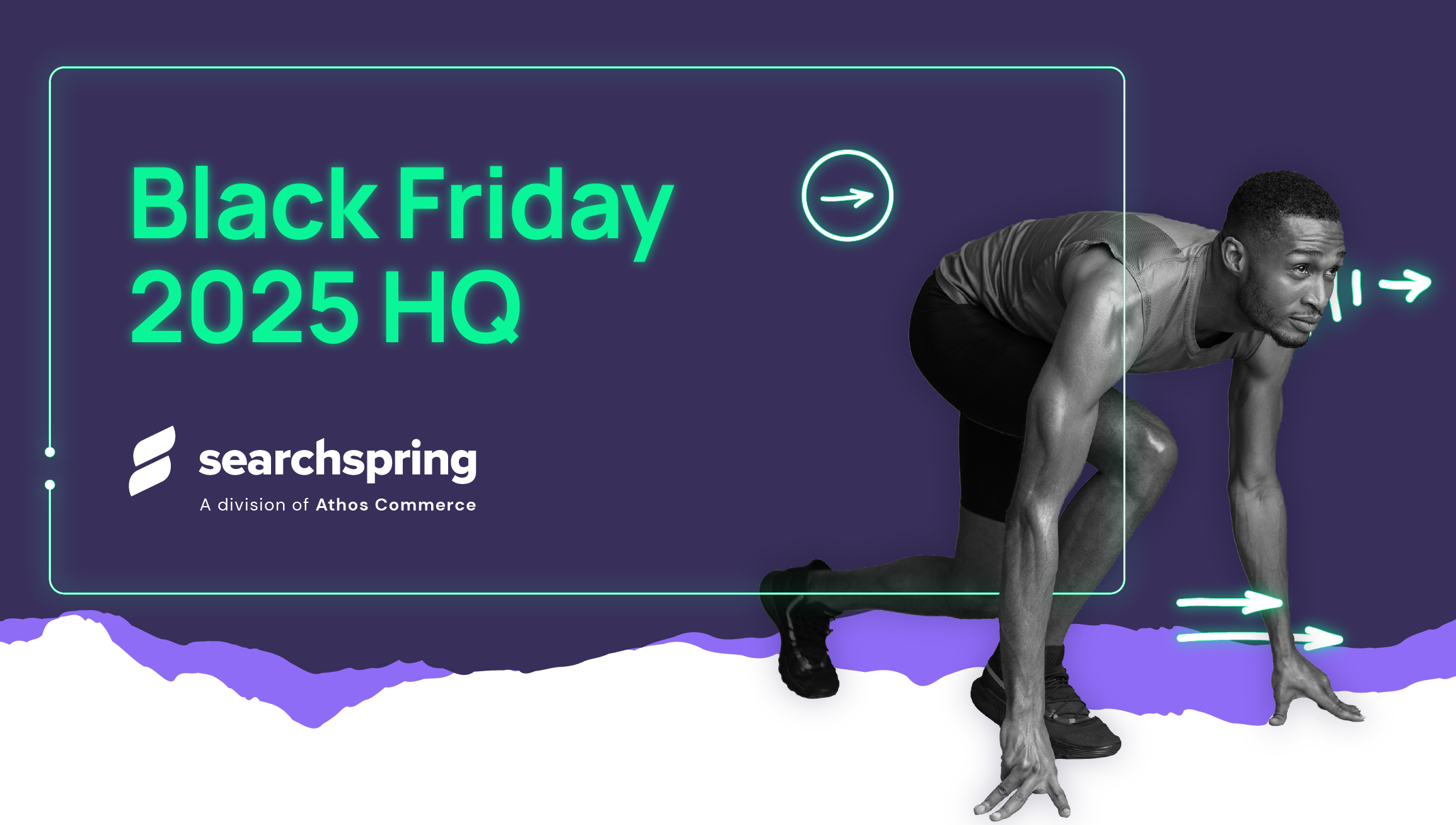Black Friday has evolved. What once revolved around doorbusters and big crowds has become an all-out digital sprint where speed, personalization, and precision define success. In our fast-paced ecommerce world, traditional merchandising tactics fall flat. Static campaigns, generic promotions, and rigid product hierarchies can’t keep up with real-time shopper behavior and expectations.
The opportunity? AI-powered merchandising—one of the many key drivers of ecommerce growth we’ve witnessed (and participated in) over the past several years. According to Adobe Analytics, U.S. online sales reached a record $10.8 billion on Black Friday 2024, marking a 10.2% increase over the previous year. Meanwhile, NVIDIA’s 2025 State of AI in Retail and CPG survey found that 89% of retailers are either actively using AI in their operations or assessing AI projects, and 91% of consumers say they’re more likely to shop with brands that offer relevant recommendations.
To win Black Friday 2025, ecommerce teams must move from static to smart. This article explores how AI-powered merchandising enables that transformation.
Why static merchandising fails in 2025
Black Friday shoppers move fast and have high expectations. They want the right product at the right time and on the right channel—without friction or delay. Static merchandising approaches, which rely on pre-programmed rules and fixed logic, simply can’t meet the pace and complexity of today’s digital retail landscape.
When merchandising rules are set weeks in advance, they can’t react to rapidly shifting inventory levels, sudden spikes in demand, or changes in consumer behavior. Outdated boosts can surface sold-out items, and rigid global rules can ignore important nuances like location, traffic source, or device behavior. Bundles that are planned once and pinned in place risk becoming irrelevant within hours of launch. Static systems are slow, siloed, and disconnected from the moment-to-moment reality of ecommerce. On Black Friday, when it matters most, these shortcomings are magnified.
AI changes everything. With real-time data inputs, adaptive algorithms, and continuous learning, AI-powered merchandising surfaces relevant products, removes friction, and updates logic dynamically across channels. Instead of hoping your merchandising setup works as planned, AI ensures that your site evolves as your shoppers do.
AI-powered product discovery
Search is the starting point for most ecommerce journeys, and it’s often the highest-intent touchpoint during Black Friday. Shoppers arrive with urgency, looking to find deals fast. If they can’t, they bounce. Traditional keyword-based search engines often fall short, delivering irrelevant results or misinterpreting shopper intent.
AI-powered product discovery transforms search from a basic utility into a strategic driver of conversions. Natural language processing (NLP) helps decipher complex, long-tail search queries, while intent modeling can recognize the difference between someone browsing “gift ideas” versus someone typing in a specific SKU. AI-enhanced discovery systems also learn from aggregate shopper behavior, surfacing trending items or adjusting search results based on promotional context, stock levels, or shopper affinities.
Rather than returning the same static list of results, AI adjusts product rankings and visibility in real time. High-converting SKUs are prioritized, promoted items show up in context, and inventory data is accounted for automatically. This means that during the most competitive shopping day of the year, your site search helps shoppers find what they want faster, smarter, and with far fewer abandoned sessions.
Personalization that converts at scale
Personalization has shifted from a buzzword to a baseline expectation, with 80% of shoppers saying they’re more likely to buy from brands that offer personalized experiences. During Black Friday, when option overload is at its peak, smart personalization helps cut through the noise.
AI makes personalization more scalable, precise, and timely. With real-time inputs from shopper behavior, browsing patterns, location, and historical data, AI engines can tailor homepage content, category pages, and product listings on the fly. Returning visitors might be welcomed with modules highlighting items they’ve previously viewed or abandoned. Shoppers engaging with gifting content might see curated collections based on that journey. Even sort orders on product listing pages can adjust dynamically to prioritize items most relevant to each shopper.
What sets AI-powered personalization apart is its ability to act in the moment. Rather than simply relying on pre-set rules, it evolves continuously based on what’s happening right now. That same intelligence extends to outbound channels. Email and SMS campaigns triggered during Black Friday can be customized to feature products based on real-time browsing and purchase behavior, creating 1:1 marketing at scale. Rather than segmenting audiences into broad buckets, AI empowers you to market to the individual.
Smarter product bundling and cross-sell strategies
Product bundling and cross-selling are proven strategies to increase average order value (AOV) and cart size, especially during high-intent events like Black Friday. But the old approach—pairing products manually or relying on static associations—limits potential impact.
AI-driven bundling takes a dynamic, data-informed approach. It analyzes transactional data to identify products that are frequently purchased together, and then tests and refines those bundles based on performance. AI considers key factors like seasonality, price elasticity, shopper behavior, and stock availability when suggesting bundle combinations, ensuring that recommendations are timely, relevant, and profitable.
For example, a shopper browsing a Black Friday deal on headphones might be offered a bundle that includes a protective hardcase, Bluetooth adapter, and cleaning kit—configured based on what similar shoppers have added to their carts. If that shopper is on mobile and browsing via social, the recommended bundle might also look different (e.g., shorter, simpler, and optimized for mobile checkout). AI can also help clear slow-moving inventory by pairing less popular items with top sellers in a way that feels valuable to a shopper.
The result? Bundling that feels curated rather than forced and that consistently delivers higher revenue per shopping session.
Feed optimization for retail channels and marketplaces
Your product feed is your storefront on platforms like Google Shopping, Meta, TikTok, and marketplaces like Amazon. During Black Friday, feed accuracy and agility directly affect performance. Disapproved products, missing attributes, or outdated pricing can cause visibility issues and lost sales.
AI helps automate and optimize feed management by continuously cleaning, enriching, and validating your product data. It can detect missing fields, flag mismatches between product names and categories, and apply dynamic labels that segment your catalog based on promotional status, seasonality, or performance tiers. In addition to improving feed health, these enhancements ensure your products are served to the right audiences with the right message at the right time.
AI can also tailor product feeds to meet the specific formatting and targeting requirements of each channel. A headline and image that performs well on Google Shopping, for example, may not be effective on TikTok. With AI, product content is automatically optimized for each site, saving time while improving campaign results. On Black Friday, when the stakes are high, that flexibility can make all the difference.
Social commerce and discovery-led merchandising
For many shoppers—especially Gen Z and younger Millennials—product discovery doesn’t start on your website. It starts on TikTok, Instagram, YouTube, or in a Meta Shop. In fact, according to a Forbes Advisor and Talker Research study, 45% of Gen Z shoppers prefer to discover new products through social media rather than Google. Meanwhile, 76% of U.S. shoppers have purchased a product they saw in a brand’s social media post at some point during their shopping journey.
AI plays a crucial role in making your social commerce strategy effective. Rather than serving the same static ad to every audience segment, AI enables adaptive content that responds to real-time engagement signals. Shoppers who have clicked on skincare content, for example, might see personalized carousels of trending products in that category. Limited-time offers or inventory-based promotions can be triggered automatically based on stock status and audience behavior.
Additionally, AI helps bridge the gap between social inspiration and ecommerce conversion. It optimizes product experiences for mobile and social, adapts creative elements to match audience preferences, and bundles related products to encourage larger carts. As social platforms continue to become transactional spaces, AI ensures your merchandising adapts to the discovery-first mindset.
Smarter merchandising wins
Black Friday 2025 will be a test of how quickly and intelligently brands can respond to shopper behavior. Merchandising strategies that remain static will fall behind, bogged down by manual effort, outdated logic, and generic experiences.
AI-powered merchandising flips that script. It delivers the intelligence, flexibility, and speed that high-performing ecommerce teams need to meet shoppers in the moment across search, personalization, bundling, feeds, marketplaces, and social channels. It turns behavior into insight, insight into action, and action into revenue.
Ready to power smarter Black Friday results? Book your complimentary merchandising audit with Athos Commerce today.




